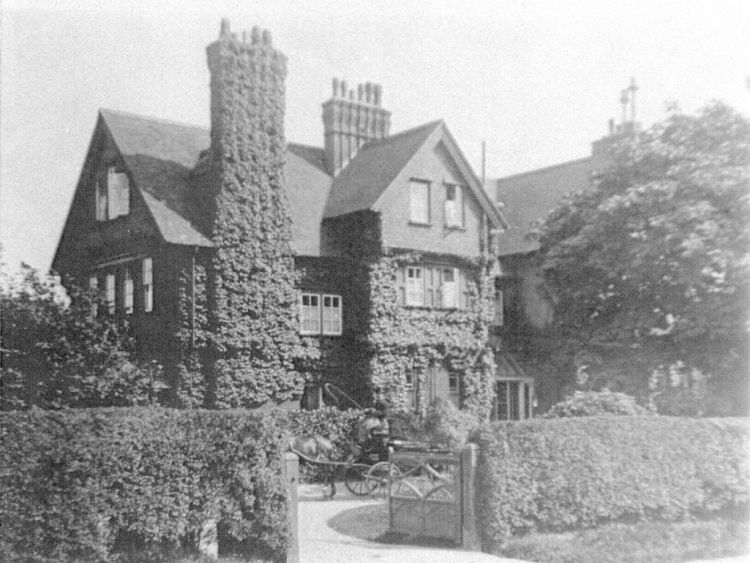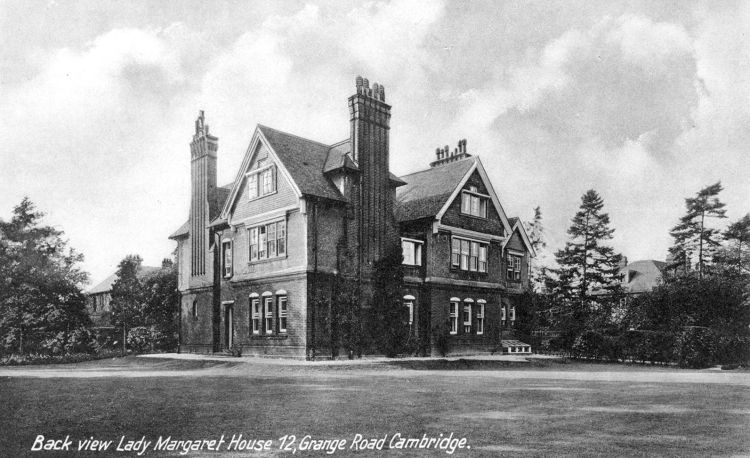This page is a research work in progress, to document the history of the site now known as 12–14 Grange Road, Cambridge. This page will be updated as more information becomes known.
The site of 12 Grange Road was originally part of the glebe lands belonging to the Vicarage of the parish of St Sepulchre in Cambridge (commonly known as the Round Church). Ordnance Survey maps deriving from the 1886 survey show the site laid out as allotments, with no buildings.
On 1889 September 29, the site was leased by the Vicar for a term of 99 years to Harry Gleaves Few (1848–1931), who caused the house to be built in 1890. Harry Few, originally a corn merchant, later became a Justice of the Peace, and Alderman of Cambridgeshire.
The original name of the house was Berrycroft (sometimes seen spelled as Berry Croft, but Berrycroft appears to be the authentic form). [The Few family came from Willingham, where there is a street named Berrycroft].
This photograph, possibly from the 1920s, shows Berrycroft with the Few’s horse-drawn open carriage, viewed from Grange Road.
After Harry Few died in 1931, the lease of the site and the house passed, by the terms of his will, to a group of his children. The house appears to have had no occupant for a while [Spalding’s Street Directory 1931–32 to 1933–34].
From 1934, the occupier of Berrycroft was Alethea Mary Newsom née Awdry (1886–1961), widow of George Ernest Newsom (1871–1934), Master of Selwyn College 1928–34 [Spalding’s Street Directory 1934–35 to 1936–37; Kelly’s Directory 1937].
On 1937 August 4, the descendants of Harry Few who had inherited the site and house at his death, sold the residue of the 99-year site lease and the house to members of the Congregation of Our Lady, Canonesses of St Augustine, from the community at the “Les Oiseaux” convent at Westgate-on-Sea, Kent. [The Westgate community had been founded around 1904 by sisters of the Congregation of Our Lady fleeing from France. Their “Les Oiseaux” convent and girls’ boarding school in Paris had been closed after a law of 1904 prohibited schools run by the church. The Westgate community ran a girls’ boarding school, which closed in 1972: the buildings were then used as a school by St Augustine’s College, which closed in 1995. The convent buildings are now a function venue.]
Berrycroft was renamed “Lady Margaret House” (sometimes referred to as “Lady Margaret Convent”).
Continuing the Congregation’s commitment to girls’ education, they took in female students studying for college entrance examinations.
At that time, the Catholic Chaplaincy in the University, at Fisher House, was reserved exclusively for men. In 1939, the Oxford & Cambridge Catholic Education Board asked the sisters at Lady Margaret House to “look after the spiritual needs of the women at Cambridge University in co-operation with Father Adrian English”.
An association of the Catholic women of Newnham and Girton Colleges was set up, known as the “Margaret Beaufort Society”, just as the men had a “Fisher Society”. A room in the house served as a chapel.
During the Second World War, a number of London colleges, including Bedford and L.S.E., were evacuated to Cambridge, and Lady Margaret House helped to provide accommodation for them.
On 1949 July 8, the community of sisters purchased the residue of the lease for the adjacent house, 10 Grange Road, which, like number 12, had originally been part of the glebe lands of St Sepulchre.
On 1952 November 19, the community of sisters purchased the freeholds of both 10 and 12 Grange Road from the Vicarage of the parish of St Sepulchre.
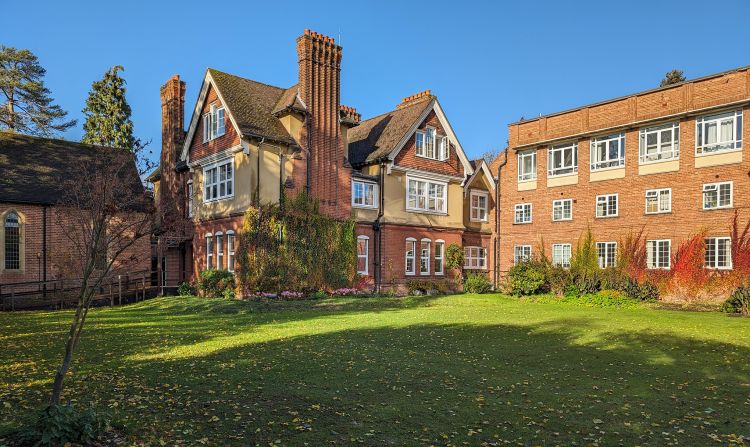 In 1954/55, a chapel was erected to the south of the house. The architect was John-Baptiste Sebastian Comper (1891–1979), F.R.I.B.A, of 12 Douglas House, 6 Maida Avenue, London W2. The contractor was William Sindall, of Cambridge.
In 1954/55, a chapel was erected to the south of the house. The architect was John-Baptiste Sebastian Comper (1891–1979), F.R.I.B.A, of 12 Douglas House, 6 Maida Avenue, London W2. The contractor was William Sindall, of Cambridge.
In 1960/61, a 2-storey extension was erected to the north-east of the house. This comprised offices and common rooms on the ground floor, and bedroom “cells” for the sisters on the first floor. This extension was given the address 14 Grange Road. The architects were Walters & Kerr Bate of 14 Gray’s Inn Square, London, WC1. In 1965/66, the same architects added a third storey, creating a Library.
In 1965, the previously male-only Catholic Chaplaincy at Fisher House became mixed-sex. The “Margaret Beaufort Society” for Catholic women ceased to exist.
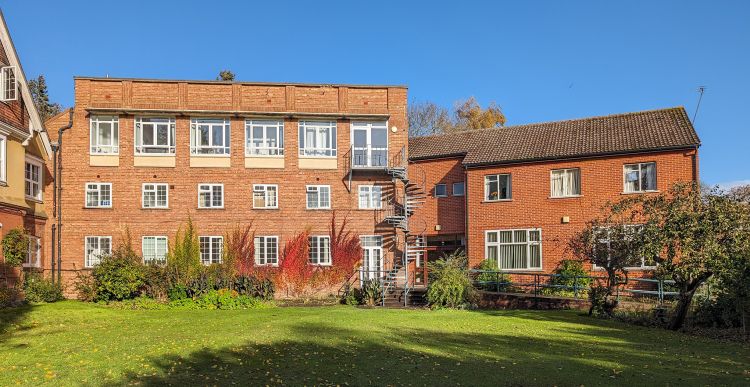 On 1984 December 7, the Sisters of the Congregation of Our Lady sold the 10 Grange Road site and house. However, what had been the far end of the garden of 10 Grange Road was retained, and is now an orchard attached to the garden of 12 Grange Road.
On 1984 December 7, the Sisters of the Congregation of Our Lady sold the 10 Grange Road site and house. However, what had been the far end of the garden of 10 Grange Road was retained, and is now an orchard attached to the garden of 12 Grange Road.
In 1986/87, a second accommodation extension was added to the east of the earlier one. The architect was Francis Hookham (1931–2020), of 1 Northampton Street, Cambridge.
During the 1990s, spare accommodation bedrooms began to be let to general university students, particularly post-graduates.
In 2001, an external escape staircase was added to the east end of the 2nd-floor Library.
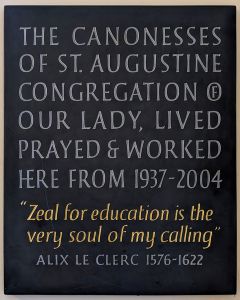 In 2003, the site was purchased by the Margaret Beaufort Institute of Theology, a lay Catholic institute, whose earlier history is recounted here.
In 2003, the site was purchased by the Margaret Beaufort Institute of Theology, a lay Catholic institute, whose earlier history is recounted here.
The Institute took over the main house, while the Sisters of the Congregation of Our Lady occupied rooms in the accommodation extensions.
In 2019, a refurbishment project included the conversion of the 2nd-floor Library to units of en-suite bedrooms.
In 2023, the site was purchased by Queens’ College, to be used as student accommodation, in the main house and the two extensions. The former chapel (now de-consecrated) might be evaluated as a possible archive centre.
The Margaret Beaufort Institute of Theology relocated to Wesley House in Jesus Lane.
The house at 12 Grange Road is designated by the local planning authority as a “Building of Local Interest”.
Links to related pages
- 12 Grange Road, Berrycroft at Capturing Cambridge.
Sources, References, and Further Reading
1931: Alderman Few : Long service for Cambridgeshire, in The Times, No. 45793, 1931 April 10, p. 14. [Obituary]
1990: Berrycroft Memories, ed. Maurice E. Few, Janet R. Glover, et al. [Printed copy at Museum of Cambridge]
199x: Historical Outline [of Lady Margaret House], anonymous, undated, typescript.
